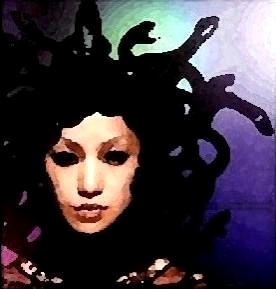|
Pino Blasone, |
Chimere. Miti in versi |
|
|
Introduzione La mitologia, specialmente quella greca, è un po' il Fantasy e insieme
la fantascienza dell'antichità. In effetti i miti si prestano ad essere
attualizzati, forse perché concepiti apposta per esercitare una suggestione
duratura e un potere evocativo ricorrente. Non sono mai mancati poeti e
artisti, narratori o autori di teatro e anche di cinema, che si sono dedicati
a tale operazione sia pure occasionalmente. Nel campo della danza e della
musica, basti ricordare l’opera moderna della coreografa nord-americana
Martha Graham, in gran parte ispirata alla mitologia classica. La rivisitazione del mito è stata un esercizio letterario
praticato perfino nell'era della tecnica. Piace qui citare Eurydice in the
Underworld di Kathy Acker, Meine Schwester Antigone di Grete Weil,
Dialoghi con Leucò di Cesare Pavese (per quanto riguarda la poesia, Sonetten
an Orpheus di Rainer M. Rilke, Poemi conviviali di Giovanni
Pascoli, Ulysses and Circe di Robert Lowell e alcune Laudi di Gabriele D’Annunzio o più Cantos di
Ezra Pound...). Non privo di una carica inquietante e straniante, a suo modo
il mito è un archetipo futuribile, per utopico o “distopico” che sia. Senza troppe pretese liriche, questa raccolta di versi vuol essere
una narrazione in forma a volte impersonale, mirata a ricreare le particolari
atmosfere suggerite dai miti adattandole alla realtà presente. È altresì il
tentativo di decifrare un messaggio, di cui non di rado il mito è portatore.
Con un espediente teatrale, altre volte sono gli stessi personaggi a narrare
le mitiche vicende di cui sono stati partecipi e testimoni, cioè le loro
storie ovvero la storia dal proprio punto di vista. Se variazioni e contaminazioni del mito sono usi antichi, in una
libera finzione attuale anacronismi e dislocazioni sono di prammatica. Ciò è
vero al punto che, con un gioco di parole, il sottotitolo della raccolta
“miti in versi” potrebbe leggersi “miti inversi”. Oppure al limite, se si
preferisce, “miti perversi”. Nondimeno, permane una fedeltà di fondo alla
tradizione. I protagonisti sono chiamati a riflettere sul passato e a
valutare l’avvenire, alla luce delle loro presunte esperienze. Quel futuro è
il nostro tempo, almeno nella misura in cui gli eventi mitici si
rappresentano sulla scena senza tempo dell’inconscio. Anzi, nella probabile
ipotesi che essi fungano da ponte immaginario tra inconscio collettivo e
inconscio individuale. * |
Introduction Mythology, especially Greek mythology, is a
sort of Fantasy and of Science Fiction of the ancient times. Actually, myths
look nearly easy to be updated, maybe for they were just conceived in order to make
a lasting impression and to effect a recurrent evocative power. Though
occasionally, there were always poets and artists, writers and authors of
theatre or still of cinema, who devoted themselves to such a deed. In the
field of modern dance and music, let us remember the ballets of
North-American choreographer Martha Graham, mainly inspired by classical mythology. Revisiting myths has been a literary
exercise, even in the age of technics. Here I like to mention Eurydice in
the Underworld by Kathy Acker, Meine Schwester Antigone by Grete
Weil, Dialoghi con Leucò by Cesare Pavese (as to poetry, Sonetten
an Orpheus by Rainer M. Rilke, Poemi conviviali by Giovanni
Pascoli, Ulysses and Circe by Robert Lowell and some Laudi by Gabriele D’Annunzio or several Cantos by Ezra
Pound...). Quite often not lacking in something odd and ravishing, in
a peculiar way the myth is a futuristic archetype, utopian or
“dystopian” we may consider it. This collection of poems has few lyric
ambitions. It consists of narrative poetry, sometimes in an impersonal form,
whose aim is to adapt to the present the special atmospheres suggested by
ancient myths. It is also an attempt to decode some messages, the myths seem
to be entrusted with. Elsewhere, with a theatrical expedient, mythical
characters are called to tell stories in which they participated and which
they can give evidence about. Not seldom, those are not only their own or
singular stories, but become a sum of points of view on the history too. Myths were already wont to be varied and
contaminated. In a free fiction, anachronism and dislocation are a today
custom. What is so true that – with a play on words – the Italian sub-title
of this collection “miti in versi” might be read “miti inversi”, not “myths
in verse” but “inverse myths”. Nevertheless, there is some fidelity to
tradition. Protagonists consider the past and value the future, in a light
from their presumed experiences. That future is our time, as long as mythical
events perform on the timeless stage of our consciences, or rather by a
probable supposition: that myths work like an imaginary bridge, between the
collective and the individual unconscious. *
|
|
|
|
|
* Per gli originali
dei miti, un riferimento multiculturale è il sito Web Timeless Myths. Circa la
traduzione poetica o la poesia narrativa, a volte anche detta “speculative
poetry”, si segnalano le seguenti riviste online in inglese: LanguageandCulture.net, Zone Magazine,
Illogical Muse,
Calenture: A Journal of Studies
in Speculative Verse.

